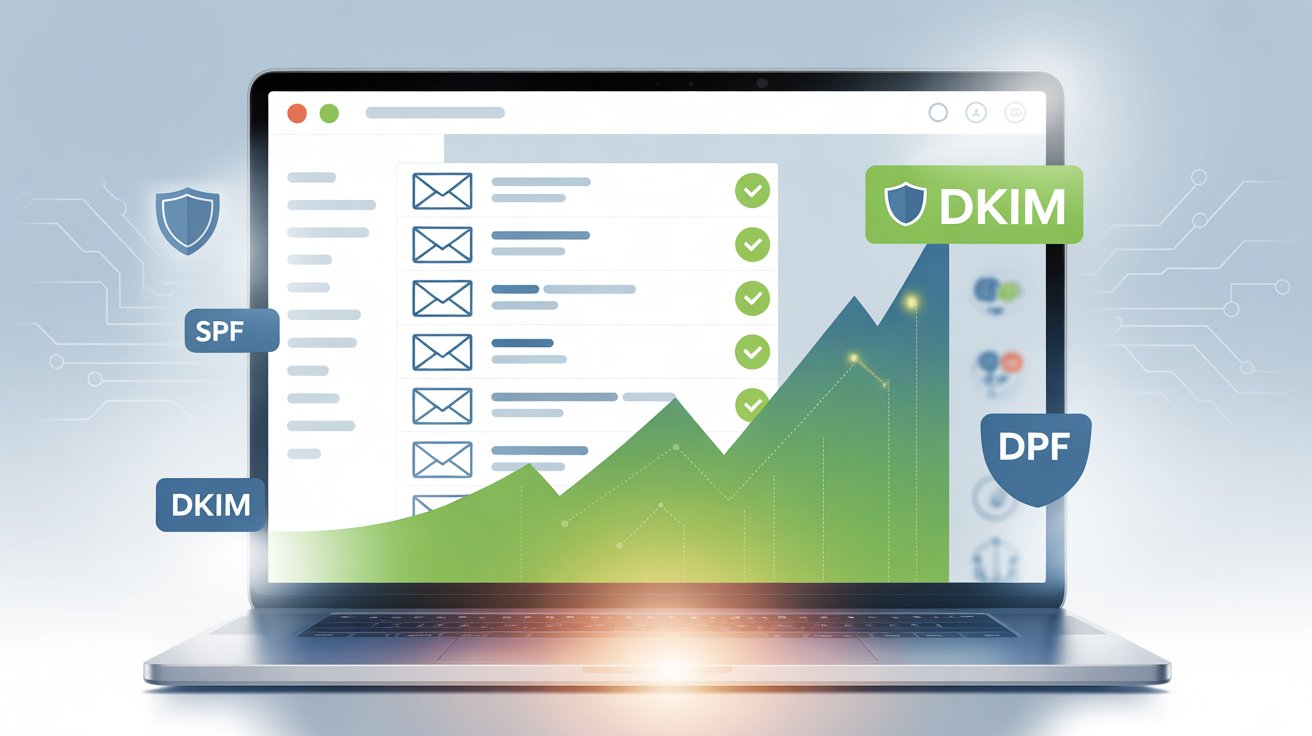If your outreach emails are landing in spam, you’re not alone. I’ve been there, watching my carefully crafted cold emails disappear into the void while my inbox stays disappointingly quiet.
Here’s the harsh truth: new or inactive email accounts combined with cold outreach create a perfect storm for low deliverability. Email providers see sudden sending spikes as suspicious behavior. Without a proper warm-up, your messages never reach your prospects.
I created this guide to solve that problem once and for all. You’ll discover how email warmup tools work, which ones deliver real results, and the exact strategies I use to land emails in inboxes consistently. Whether you’re choosing your first tool or upgrading your current setup, I’ll walk you through everything you need to know.
What Are Email Warmup Tools & Why You Need Them
What Exactly Are Email Warmup Tools?
Email warmup tools are software platforms that automate the process of building your sender reputation. They gradually increase your sending volume while simulating real email engagement—opens, clicks, and replies.
Think of them as your behind-the-scenes team. They send emails from your account to a network of real email addresses, receive replies, and create natural conversation patterns. This tells email providers like Gmail and Outlook that you’re a legitimate sender, not a spammer.
Why These Tools Matter for Your Business
I’ve tested countless outreach campaigns, and deliverability makes or breaks results. Even the best email copy fails if it hits spam folders.
Email warmup tools solve three critical problems. First, they build sender reputation gradually, which keeps you off spam lists. Second, they help you avoid spam filters by establishing positive engagement signals. Third, they let you scale your outreach safely without triggering red flags.
The email deliverability market has exploded recently. More businesses now recognize that investing in the best email warmup tools isn’t optional—it’s essential for revenue growth. Once your sender reputation is strong, the next step is launching your campaigns effectively. Check out my full guide on the best cold email software to automate outreach and maximize deliverability.
When You Absolutely Need Warm-Up Tools
You need email warmup tools in three specific situations. I learned this the hard way after several campaigns tanked.
New domain launches require a warm-up. Your domain has zero reputation, so providers treat every email with suspicion. Start warming up before you send a single outreach email.
Switching email providers also resets your reputation. Even if your old account performed well, your new setup starts from scratch.
High-volume cold outreach demands warm-up tools. If you’re sending hundreds or thousands of emails monthly, manual warm-up becomes impossible. Tools handle the complexity while you focus on crafting great messages.
How Email Warmup Works
The Technical Side: Building Your Digital Foundation
Email warmup starts with authentication. I always verify SPF, DKIM, and DMARC records before launching any campaign.
SPF records tell receiving servers which IPs can send from your domain. DKIM adds a digital signature to verify your emails haven’t been tampered with. DMARC ties everything together and tells providers what to do with suspicious emails.
Sender reputation functions like a credit score for your email account. Email providers track your sending patterns, engagement rates, and spam complaints. Higher reputation means better inbox placement.
IP and domain warm-up work together. Your IP address needs reputation building just like your domain. Email warmup tools manage both simultaneously.
The Behavioral Side: Acting Like a Real Person
Technical setup alone doesn’t guarantee inbox placement. Your sending behavior matters just as much.
Gradual send volume increases signal legitimacy. Email warmup tools start with just a few emails daily, then slowly ramp up over weeks. Sudden volume spikes trigger spam filters instantly.
Real replies create powerful trust signals. When your warm-up emails receive responses and you reply back, providers see authentic conversations. This dramatically improves your sender score.
Avoiding spam triggers requires constant vigilance. Tools automatically vary sending times, use natural language, and maintain proper sending intervals. These small details prevent pattern detection that flags automated systems.
Manual Warm-Up vs Tool-Based Warm-Up
I’ve tried both approaches, and the differences are stark.
Manual warm-up gives you complete control. You personally send emails to friends and colleagues, asking them to reply and mark messages as important. This works for warming up one or two accounts.
But manual warm-up has serious limitations. It’s incredibly time-consuming. You need dozens of willing participants. Scaling beyond a few accounts becomes practically impossible.
Tool-based warm-up solves these problems instantly. Email warmup tools automate everything—sending, receiving, replying, and engagement. They connect you to networks with thousands of real email addresses.
The choice becomes obvious when you’re managing multiple accounts or running serious outreach campaigns. Tools deliver consistency that manual methods simply can’t match.
Learning how to warm up an email account properly takes time. But email warmup tools compress weeks of manual work into automated processes that run 24/7.
After warming up your account, you’ll need reliable tools to send personalized messages at scale. I’ve reviewed the top email outreach tools that help you connect with prospects more effectively.
Top 10 Best Email Warmup Tools in 2025
I’ve tested dozens of platforms over the years. These are the email warmup tools that consistently deliver results for different business needs.
1. Instantly.ai
Best for: Agencies and sales teams running multiple client campaigns
Instantly.ai impressed me with its unlimited warmup capacity. I use it for managing several client accounts simultaneously without worrying about email limits.
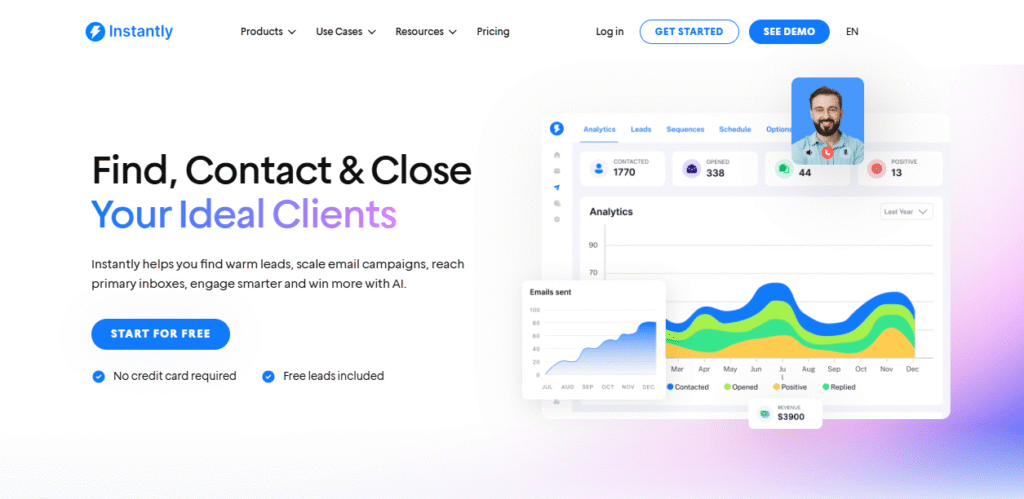
Key Features:
- Unlimited email accounts and warmup across all plans
- Built-in CRM for managing leads and conversations
- Advanced campaign analytics and tracking
- Premium support with faster response times
Pros:
- No restrictions on email account numbers
- Scales perfectly for growing agencies
- Integrated outreach and warm-up in one platform
- Clean, intuitive interface
Cons:
- Higher starting price than some competitors
- Learning curve for advanced features
- Monthly email sending limits on lower tiers
Pricing:
- Growth: $30/month (5,000 emails monthly)
- Hypergrowth: $77.60/month (100,000 emails monthly)
- Light Speed: $286.30/month (500,000 emails monthly)
- Enterprise: Custom pricing with dedicated support
For a complete breakdown of features and real campaign data, don’t miss my Instantly AI review to see how it compares to other cold email tools.
2. Smartlead.ai
Best for: Cold email automation combined with warm-up functionality
Smartlead.ai stands out because it handles both warm-up and outreach campaigns. I appreciate not needing separate tools for each function.
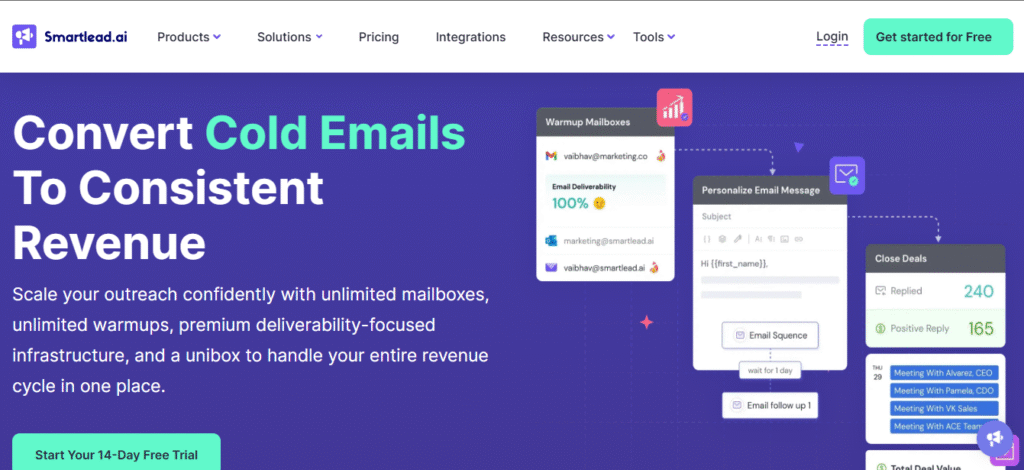
Key Features:
- Unlimited email warmup on all plans
- Dynamic IP rotation for better deliverability
- Centralized master inbox for managing responses
- ChatGPT4 integration on Pro plan
- API access for custom integrations
Pros:
- Complete cold email solution
- Unlimited team seats on Pro plan
- Dynamic sequences for personalization
- Active support and regular updates
Cons:
- Lead limits on the basic plan
- Slightly complex setup for beginners
- Add-on costs for multiple clients
Pricing:
- Basic: $32.50/month (2,000 leads, 6,000 emails)
- Pro: $78.30/month (30,000 leads, 150,000 emails)
- Client add-ons: $29/client/month
Want to see how Smartlead performs in full cold outreach campaigns? Read my complete Smartlead AI review for detailed insights and real-world results.
3. Lemwarm
Best for: startups with budget constraints
I recommend Lemwarm for anyone already using Lemlist. The integration is seamless, and the warm-up network quality impressed me.
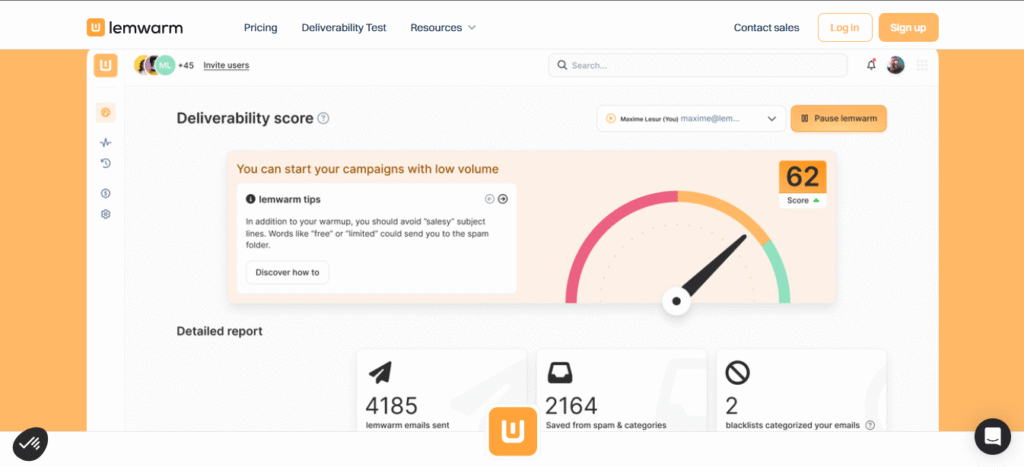
Key Features:
- Network of 20,000+ healthy domains
- Automatic technical setup verification
- Human-like warmup email patterns
- Industry-tailored warmup network on Smart plan
- Personalized warmup using your real templates
Pros:
- Affordable entry point for startups
- Perfect Lemlist integration
- Deliverability reports included
- Custom alerts for issues
Cons:
- Priced per email account
- Limited features on the Essential plan
- Best value requires an annual commitment
Pricing:
- Essential: $29/month per email ($24/month yearly)
- Smart: $49/month per email ($40/month yearly)
- Custom: Available for teams of over 10 users
Lemwarm integrates seamlessly with Lemlist. If you’re curious how the platform performs overall, check out my full Lemlist review for campaign performance and automation tips.
4. Mailflow
Best for: Beginners needing straightforward automation
Mailflow keeps things simple. I tested their free plan, and it works great for warming up a single account without complications.
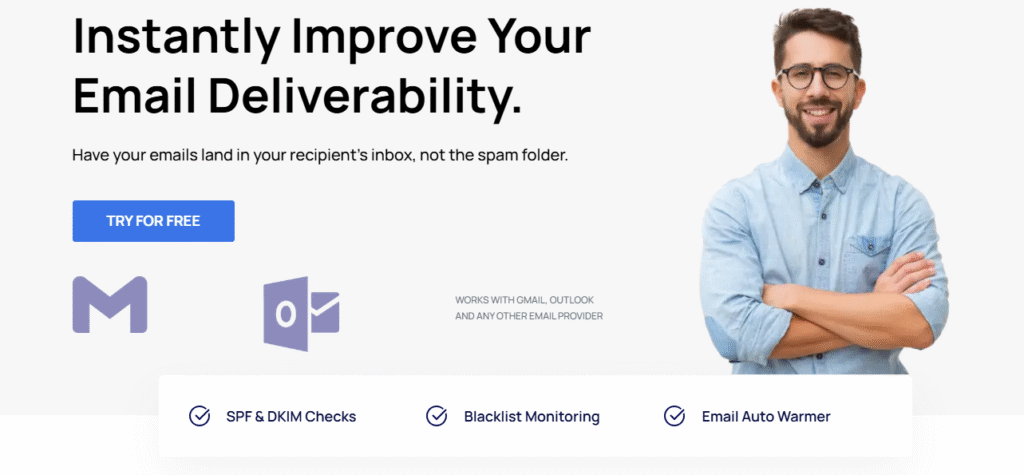
Key Features:
- SPF and DKIM technical verification
- Blacklist monitoring included
- Up to 100 email addresses per plan
- Graduated warmup email volume
Pros:
- Free plan available for testing
- No complex setup required
- Blacklist monitoring on paid plans
- Clear pricing structure
Cons:
- Limited warmup volume on the free tier
- Basic support options
- Fewer advanced features than competitors
Pricing:
- Free: Up to 5 warmup emails/day
- Silver: $49/month (30 warmup emails/day)
- Gold: $99/month (50 warmup emails/day)
5. Warmy.io
Best for: Advanced deliverability tracking and monitoring
Warmy.io focuses on serious deliverability metrics. I use it when I need detailed insights into inbox placement rates.
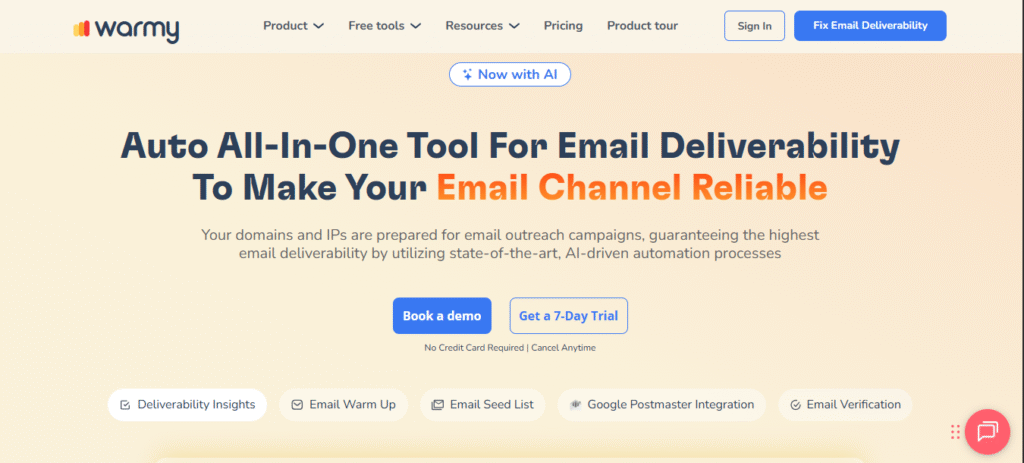
Key Features:
- Separate B2B and B2C warmup networks
- Google Postmaster integration
- Dedicated deliverability expert included
- Real-time deliverability monitoring
- Volume-based custom pricing
Pros:
- Network segmentation for better targeting
- Expert support on all plans
- Advanced monitoring tools
- Custom solutions available
Cons:
- Requires demo booking for pricing
- More expensive than basic options
- Overkill for small operations
Pricing:
- Volume-based custom pricing
- Contact sales for specific quotes
- All plans include expert support
6. Warmbox.ai
Best for: AI-powered human-like email engagement
Warmbox.ai uses artificial intelligence to create natural conversation patterns. I noticed better engagement simulation compared to basic tools.
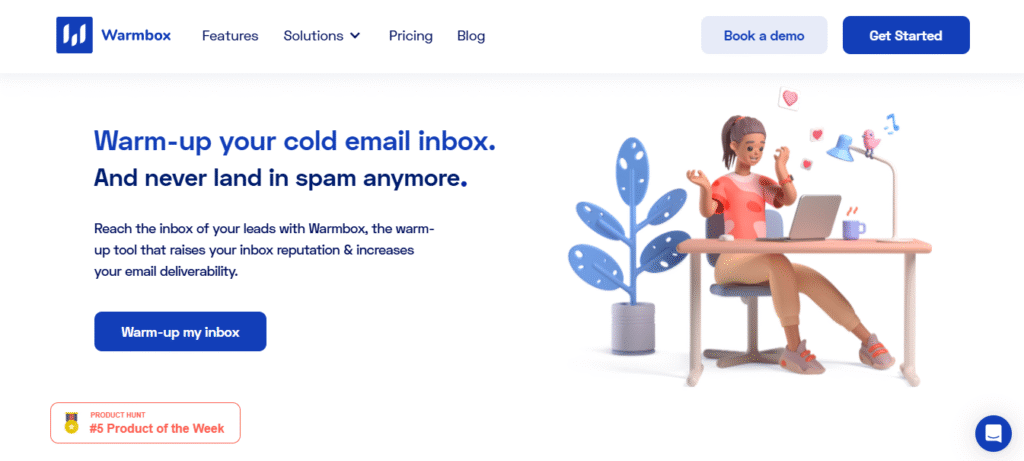
Key Features:
- AI-driven warmup conversations
- Up to 500 warm-up emails daily
- Team member collaboration
- Premium and enterprise support options
Pros:
- Very affordable solo plan
- Natural-looking email patterns
- Flexible team scaling
- Quick setup process
Cons:
- Limited daily volume on starter plans
- Fewer integrations than competitors
- Basic analytics on lower tiers
Pricing:
- Solo: $15/month (1 inbox, 50 emails/day)
- Start-up: $69/month (3 inboxes, 250 emails/day)
- Growth: $139/month (6 inboxes, 500 emails/day)
- Team: Custom pricing for larger needs
7. Folderly
Best for: Large teams and enterprise organizations
Folderly targets enterprise clients who need white-glove service. I’ve seen their team handle complex deliverability issues that other tools miss.
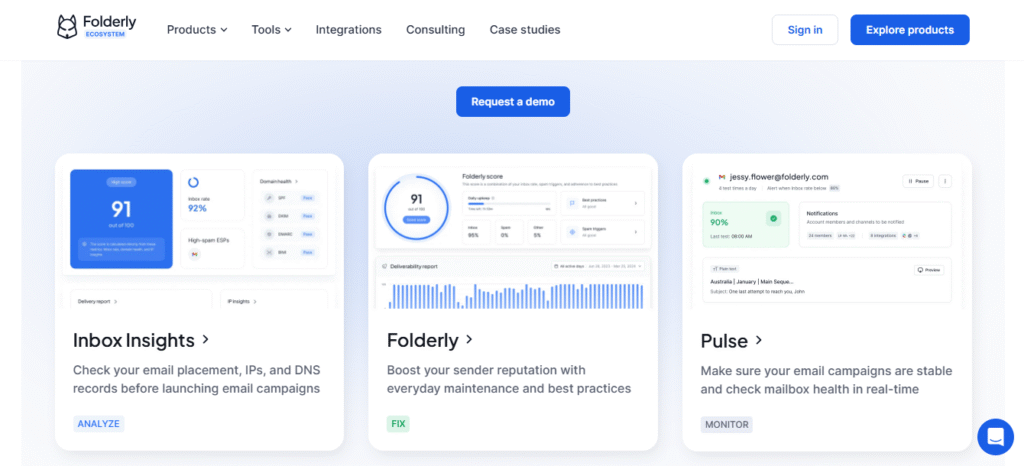
Key Features:
- Enterprise-grade deliverability solutions
- Advanced spam testing capabilities
- Dedicated account management
- Custom infrastructure setup
- Comprehensive email health monitoring
Pros:
- Best-in-class enterprise support
- Handles complex technical issues
- Customizable for large operations
- Strong reputation management
Cons:
- Premium pricing structure
- Requires longer commitment
- Overwhelming for small businesses
Pricing:
- Custom enterprise pricing only
- Contact sales for quotes
- Minimum commitment is typically required
8. Mailreach.co
Best for: Email marketers working with tight budgets
Mailreach.co offers the best value I’ve found. Their $20/month starting price includes both warmup and spam testing.
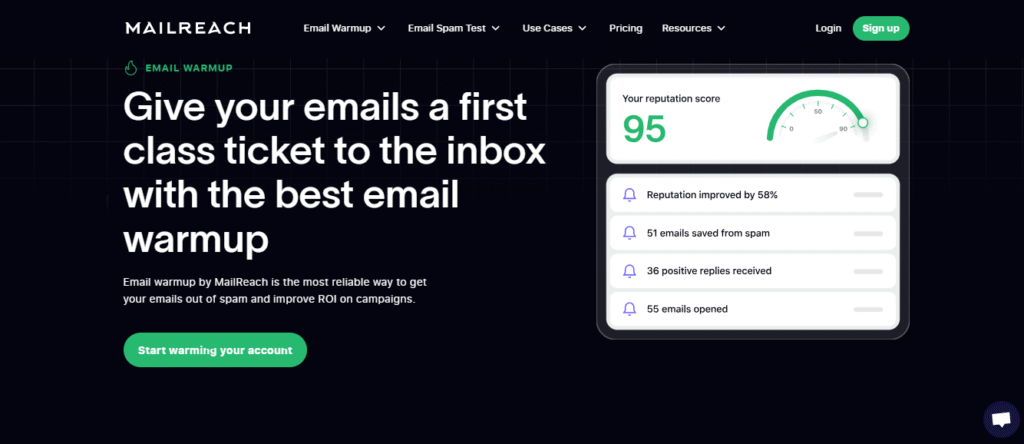
Key Features:
- AI deliverability assistant (Co-Pilot)
- Spam test credits included
- Domain and inbox health checks
- Multiple ESP warmup support
- Reputation tracking dashboard
Pros:
- Most affordable option available
- Spam testing included
- AI-powered recommendations
- Comprehensive health monitoring
Cons:
- Limited to 100 emails/day per mailbox
- Fewer team collaboration features
- Basic interface compared to competitors
Pricing:
- Starts at $20/month per mailbox
- Spam test credits: $0-$400+ depending on volume
- 20% discount on annual plans
9. Mailwarm
Best for: Users wanting a simple warm-up without extra complexity
Mailwarm does one thing well—warming up email accounts. I appreciate their focus on core functionality without feature bloat.
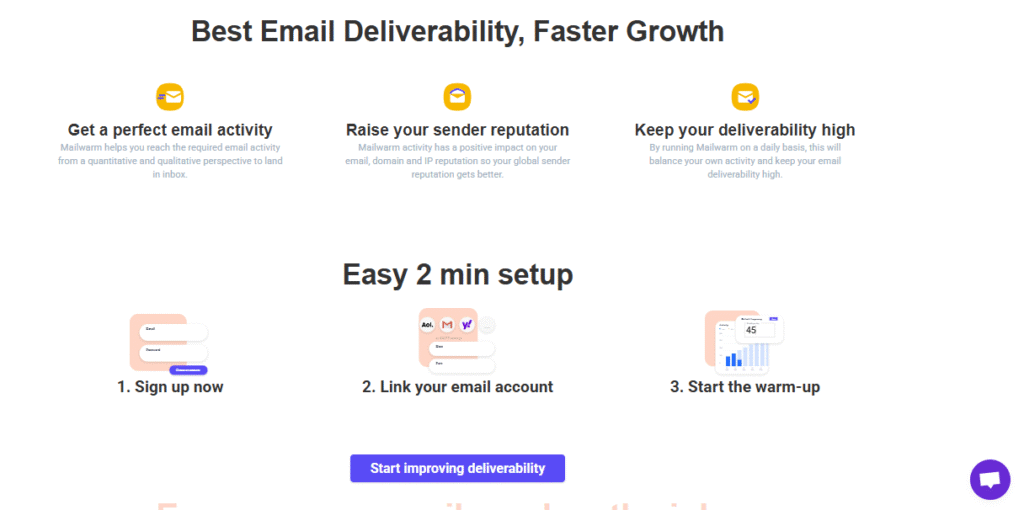
Key Features:
- Five positive actions per interaction
- Automatic bounce rate improvement
- Spam folder rescue functionality
- Important tag and starring
- Controlled reply rate settings
Pros:
- Straightforward setup and use
- Free deliverability audit on paid plans
- Multiple user access
- Annual discount available
Cons:
- No free trial option
- Limited integration options
- Basic reporting features
Pricing:
- Starter: $69/month annually ($79 monthly) – 1 account, 50 emails/day
- Growth: $159/month annually ($189 monthly) – 3 accounts, 200 emails/day
- Scale: $479/month annually ($549 monthly) – 10 accounts, 500 emails/day
10. InboxAlly
Best for: High-volume senders with serious deliverability needs
InboxAlly operates differently from typical warmup tools. They use seed email networks that interact with your campaigns directly.
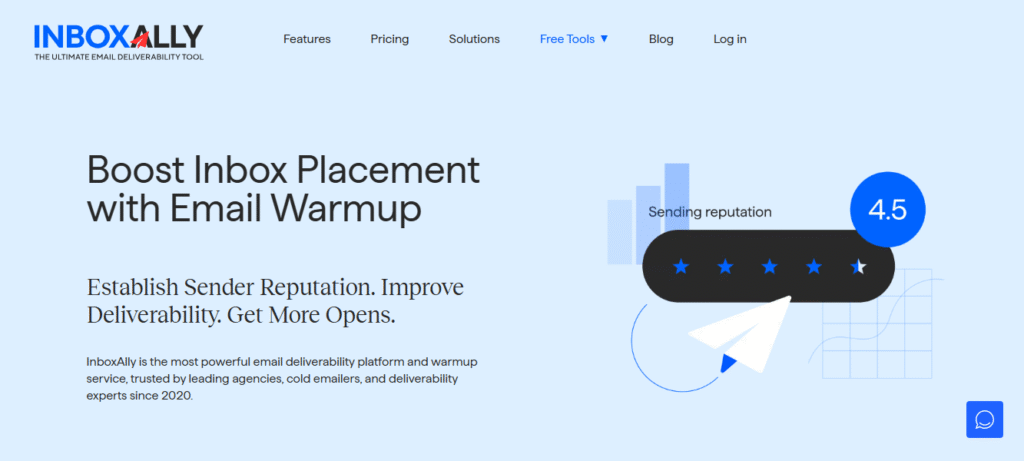
Key Features:
- Large seed email network
- Multiple sender profile management
- Live chat and phone support on premium plans
- Strategy sessions for enterprise clients
- Real campaign engagement tracking
Pros:
- Proven for high-volume campaigns
- Excellent support on higher tiers
- Strategy consulting included
- Scales to the enterprise level
Cons:
- Expensive compared to alternatives
- No free trial available
- Minimum $149/month investment
Pricing:
- Starter: $149/month (100 seed emails/day)
- Plus: $645/month (500 seed emails/day)
- Premium: $1,190/month (1,000 seed emails/day)
- Enterprise: Custom pricing for unlimited volume
Comparison Table: Top Email Warmup Tools
| Tool Name | Best For | Pricing | Key Feature | Rating |
|---|---|---|---|---|
| Instantly.ai | Agencies & sales teams | From $30/mo | Unlimited email accounts | ⭐⭐⭐⭐⭐ |
| Smartlead.ai | Cold email + warmup | From $32.50/mo | Unlimited warmup + ChatGPT4 | ⭐⭐⭐⭐⭐ |
| Lemwarm | Lemlist users & startups | From $24/mo | 20K+ domain network | ⭐⭐⭐⭐ |
| Mailflow | Beginners | Free – $99/mo | Simple automation | ⭐⭐⭐⭐ |
| Warmy.io | Advanced tracking | Custom pricing | Dedicated expert included | ⭐⭐⭐⭐⭐ |
| Warmbox.ai | AI engagement | From $15/mo | AI-powered conversations | ⭐⭐⭐⭐ |
| Folderly | Enterprise teams | Custom pricing | White-glove service | ⭐⭐⭐⭐⭐ |
| Mailreach.co | Budget-conscious marketers | From $20/mo | Spam testing included | ⭐⭐⭐⭐ |
| Mailwarm | Simple warmup | From $69/mo | 5 positive actions/email | ⭐⭐⭐⭐ |
| InboxAlly | High-volume senders | From $149/mo | Seed email network | ⭐⭐⭐⭐ |
Don’t wait for your deliverability to tank. Start your free trial with any of these email warmup software options today and watch your inbox placement rates soar.
How to Choose the Right Email Warmup Tool
Selecting the right warmup tool feels overwhelming with so many options. I’ve narrowed down the critical factors that actually matter.
Accuracy & Size of the Warm-Up Network
Network quality determines your warmup success. I always check two things: network size and email health.
Larger networks provide better reputation building. Tools with 10,000+ active email addresses create more authentic engagement patterns. Small networks often recycle the same connections, which providers can detect.
Email health matters just as much as quantity. Your warmup tool should connect you with legitimate, active accounts—not spam traps or dead addresses. Ask about their network maintenance practices before committing.
Integration with Your Email Provider/ESP & CRM
Seamless integration saves hours of manual work. I’ve wasted too much time fighting with tools that don’t play nice with my existing setup.
Check ESP compatibility first. The best email warmup tools work flawlessly with Gmail, Outlook, Office 365, and major providers. SMTP support ensures you can connect to any email account.
CRM integration becomes critical as you scale. If your warmup tool connects directly with your sales platform, you maintain clean data flow. Look for native integrations with platforms like HubSpot, Salesforce, or Pipedrive.
Automation vs Manual Control
Different campaigns need different control levels. I use automation for routine warmup, but want manual override when needed.
Full automation works perfectly for standard warmup. The tool handles sending schedules, reply timing, and volume increases automatically. You set it and forget it.
Manual control helps in specific situations. Maybe you’re warming up a sensitive domain or testing new strategies. The ability to adjust daily volumes, customize sending times, or pause campaigns gives you flexibility.
Reporting & Deliverability Metrics
Data drives decision-making. I refuse to use warmup tools that don’t provide clear performance insights.
Essential metrics include inbox placement rate, spam folder percentage, and sender reputation score. These numbers tell you if warmup actually works.
Advanced tracking separates good tools from great ones. Google Postmaster integration, blacklist monitoring, and domain health checks help you spot problems before they tank your campaigns.
Pricing & Scalability (SMB vs Enterprise)
Budget matters, but the total cost of ownership matters more. I’ve learned to calculate the real price beyond monthly fees.
Small business pricing should include core features. You need unlimited warm-up, decent sending volumes, and basic support. Budget $20-$100/month per inbox for quality tools.
Enterprise pricing adds value through scale. Look for volume discounts, dedicated support, and custom infrastructure. The best email warmup tools offer flexible pricing that grows with your business. If you’re still building your outreach list, these lead generation tools can help you find quality prospects before you start warming up emails.
Bonus Features: Going Beyond Basic Warmup
Advanced features separate basic tools from comprehensive solutions. I prioritize these extras when choosing between similar platforms.
Dedicated IP support helps high-volume senders. If you’re sending 100,000+ emails monthly, dedicated IPs provide better control over reputation.
Domain health monitoring prevents disasters. Automatic alerts about blacklist appearances, DNS issues, or authentication problems let you fix issues fast.
White-labeling matters for agencies. If you’re managing client campaigns, branded reporting, and client portals, justify premium pricing.
Quick Selection Checklist
- ✅ Network size over 10,000 active addresses
- ✅ Compatible with my email provider
- ✅ Integrates with my CRM/sales tools
- ✅ Provides inbox placement metrics
- ✅ Fits within my monthly budget
- ✅ Scales as my sending volume grows
- ✅ Offers responsive customer support
- ✅ Includes domain health monitoring
- ✅ Allows volume control when needed
- ✅ Provides free trial or demo
Ready to make your choice? Start free trials with 2-3 top contenders from our list. Test them with real accounts and compare results before committing long-term.
Conclusion
I’ve walked you through everything you need to know about email warmup tools. The right tool, combined with proper implementation, dramatically improves your deliverability rates.
Your next step is simple: pick one tool from this list that matches your budget and needs, and compare your top choices.
Start warming up your email accounts at least two weeks before launching your next campaign. This patience pays off with inbox placement that actually converts.
Want more outreach tool reviews? Visit AIOutreachTool.com for full-stack reviews & strategies that help you dominate cold outreach.
Frequently Asked Questions
What are the best email warmup tools for beginners?
I recommend Mailreach.co or Warmbox.ai for beginners. Mailreach.co starts at just $20/month with excellent features and an AI assistant that guides you. Warmbox.ai offers a $15/month solo plan that’s perfect for testing warmup without major investment. Both tools provide simple interfaces and don’t require technical expertise to get started.
Do email warm-up tools really improve deliverability?
Yes, email warmup tools significantly improve deliverability when used correctly. I’ve seen inbox placement rates jump from 40% to 85%+ after proper warmup. These tools build sender reputation gradually by creating authentic engagement patterns that email providers trust. However, warmup alone won’t fix terrible email copy or purchased lists—you still need quality content and legitimate contacts.
How long should email warm-up take?
Email warmup typically takes 2-4 weeks for new accounts. I never rush this process because providers detect sudden changes. Start with 10-20 emails daily and increase by 10-15% each week. Older accounts being reactivated need 1-2 weeks minimum. High-volume senders should plan 4-6 weeks to safely reach full capacity without triggering spam filters.
Can I warm up an email account for free manually?
Yes, you can warm up an email account manually for free, but it’s time-consuming and limited. Send personal emails to friends and colleagues, ask them to reply, and mark you as important. Exchange emails with 10-15 people daily, gradually increasing volume over 3-4 weeks. This works for 1-2 accounts but becomes impossible at scale. Email warmup tools automate this process with larger networks for better results.
What’s the difference between domain warm-up and email warm-up?
Domain warmup builds a reputation for your entire domain (like company.com), while email warmup focuses on individual email addresses. Domain reputation affects all emails from your domain and takes longer to establish. Email warmup concentrates on specific sender addresses and their engagement patterns. The best email warmup tools handle both simultaneously—warming your domain reputation while building individual sender credibility for maximum deliverability.
Is using warm-up tools safe/legal?
Yes, email warmup tools are completely safe and legal. They simulate natural email behavior that complies with all email service provider terms. These tools don’t send spam, hack systems, or violate regulations. Major ESPs like Gmail and Outlook don’t prohibit warmup—they actually prefer gradual sending increases over sudden volume spikes. Just ensure you use reputable tools that follow best practices and avoid services that promise unrealistic results.

